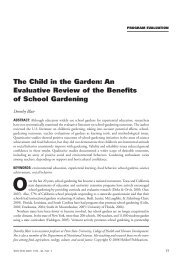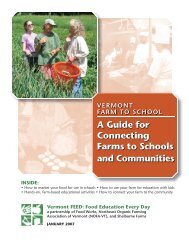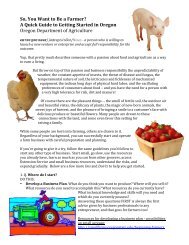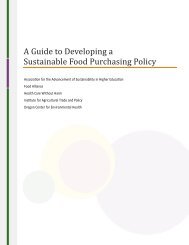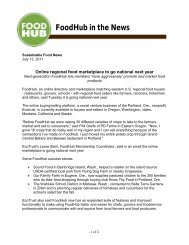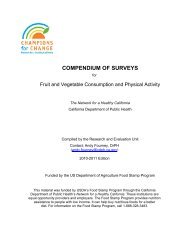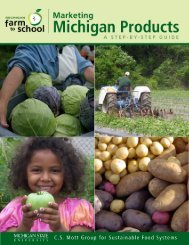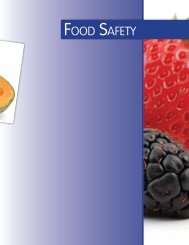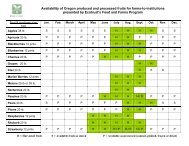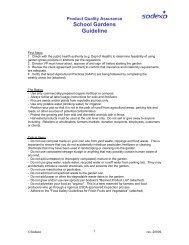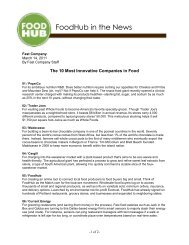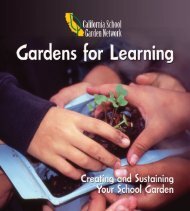eval report cover.indd - New Jersey Farm to School Network Wiki
eval report cover.indd - New Jersey Farm to School Network Wiki
eval report cover.indd - New Jersey Farm to School Network Wiki
Create successful ePaper yourself
Turn your PDF publications into a flip-book with our unique Google optimized e-Paper software.
SFP-NY: SCHOOL FOOD PLUS PROGRAM,NEW YORK CITY SCHOOLS, NEW YORKConclusions <strong>Farm</strong> <strong>to</strong> <strong>School</strong> and RecommendationsProgram Profiles<strong>School</strong>FoodPlus was a project of Food-Change. Market Ventures, Inc. in partnershipwith Karp Resources and the Centerfor Health & Public Service Research at <strong>New</strong>York University were retained <strong>to</strong> <strong>eval</strong>uate the<strong>School</strong>FoodPlus Initiative.Th e logic model for the <strong>School</strong>FoodPlus <strong>eval</strong>uationreflected the three pronged approach <strong>to</strong>wardachieving the goals of improving children’s healthand academic performance while invigoratingthe state’s agricultural economy. These includedinstitutional change within the <strong>New</strong> York CityOffice of <strong>School</strong>Food (OSF), school-based programming,and coalition building.Most of the school-based programming for<strong>School</strong>FoodPlus <strong>to</strong>ok place at the elementaryschool level in three targeted neighborhoodsaround <strong>New</strong> York City. These were low incomeneighborhoods identified as catchment areas forintense focus – East and Central Harlem, the South Bronx and Central Brooklyn. Key questionsthe <strong>eval</strong>uation was designed <strong>to</strong> answer were:1. How have <strong>School</strong>Food Plus recipes been utilized by OSF and participating schools?2. Has students’ consumption of <strong>School</strong>Food Plus recipes increased in participating schoolsand why?3. Has <strong>School</strong>Food Plus led <strong>to</strong> increases in the number of students eating school meals?4. How have students, teachers, administration, parents, and coalition partners responded<strong>to</strong> <strong>School</strong>Food Plus?5. Does participation in CookShopB Cafeteria or CookShopB Classroom lead <strong>to</strong> change inknowledge, attitude, and behavior about food, farming, cooking, and consumption compared<strong>to</strong> non-participants?6. Have the three different combinations of <strong>School</strong>Food Plus programming (cafeteria only,classroom only, or saturation intensive model) led <strong>to</strong> different outcomes in terms of studentknowledge, attitudes, behavior, and program satisfaction?7. How has procurement of locally grown fruits and vegetables changed as a result of<strong>School</strong>Food Plus and who are the participating farmers?8. How has participating in <strong>School</strong>Food Plus affected local farmers, individually and in aggregate?9. What value have the various coalitions added <strong>to</strong> the <strong>School</strong>Food Plus program?<strong>School</strong> Food Plus Evaluation, Interim Evaluation, Phase 2 Report, Oc<strong>to</strong>ber 2005.<strong>New</strong> York City <strong>School</strong>s(citywide data for 2005-06)Free / reduced mealeligibility: 73.7%Total schools: 1,456Enrollment: 10,71,630Demographics (2004-05 data):14.3 % White, 33.1 % African American,39% Hispanic, 13.5% Asian and othersLocal product used in:<strong>School</strong> mealsOther program components:Recipe development/ testing, reviewof nutrition standards, CookShop /other curricula, Cafeteria as a Classroomprogram, SPARK physical educationprogram, coalition building nutritioninterventions for parents/ community<strong>School</strong> Food Plus Interim Evaluation Phase 3 Report, April 2007.80 Bearing Fruit: <strong>Farm</strong> <strong>to</strong> <strong>School</strong> Evaluation Resources and Recommendations



